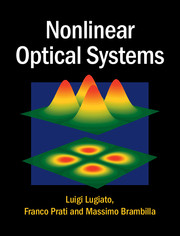Book contents
- Frontmatter
- Dedication
- Contents
- Preface
- Part I Models, propagation, stationary phenomena
- 1 The rate-equation model for the laser
- 2 The interaction of a system of two-level atoms with the electromagnetic field
- 3 The Maxwell–Bloch equations
- 4 Inclusion of the irreversible processes in the atomic equations
- 5 Propagation in irreversible Maxwell–Bloch equations
- 6 Optical nonlinearities. Materials with quadratic nonlinearities
- 7 Optical nonlinearities. Materials with cubic nonlinearities
- 8 Optical resonators. The planar ring cavity. Empty cavity. Linear cavity
- 9 A nonlinear active ring cavity: the ring laser, stationary states
- 10 The adiabatic elimination principle
- 11 A nonlinear passive ring cavity: optical bistability
- 12 Modal equations for the ring cavity. The single-mode model
- 13 Single- and two-mode models
- 14 Nonlinear dynamics in Fabry–Perot cavities
- 15 Inhomogeneous broadening
- 16 The semiconductor laser
- 17 Lasers without inversion and the effects of atomic coherence
- Part II Dynamical Phenomena, Instabilities, Chaos
- Part III Transverse optical patterns
- Appendix A The Routh–Hurwitz stability criterion
- Appendix B Calculation of the oscillatory instability boundary
- Appendix C Coefficients of the characteristic equation (20.20)
- Appendix D Derivation of equations (20.27) and (20.28)
- Appendix E Coefficients of equations (20.60) and (20.61)
- Appendix F The exact boundary of the Risken–Nummedal–Graham–Haken instability
- Appendix G Nonlinear analysis of the roll solution
- References
- Index
14 - Nonlinear dynamics in Fabry–Perot cavities
from Part I - Models, propagation, stationary phenomena
Published online by Cambridge University Press: 05 March 2015
- Frontmatter
- Dedication
- Contents
- Preface
- Part I Models, propagation, stationary phenomena
- 1 The rate-equation model for the laser
- 2 The interaction of a system of two-level atoms with the electromagnetic field
- 3 The Maxwell–Bloch equations
- 4 Inclusion of the irreversible processes in the atomic equations
- 5 Propagation in irreversible Maxwell–Bloch equations
- 6 Optical nonlinearities. Materials with quadratic nonlinearities
- 7 Optical nonlinearities. Materials with cubic nonlinearities
- 8 Optical resonators. The planar ring cavity. Empty cavity. Linear cavity
- 9 A nonlinear active ring cavity: the ring laser, stationary states
- 10 The adiabatic elimination principle
- 11 A nonlinear passive ring cavity: optical bistability
- 12 Modal equations for the ring cavity. The single-mode model
- 13 Single- and two-mode models
- 14 Nonlinear dynamics in Fabry–Perot cavities
- 15 Inhomogeneous broadening
- 16 The semiconductor laser
- 17 Lasers without inversion and the effects of atomic coherence
- Part II Dynamical Phenomena, Instabilities, Chaos
- Part III Transverse optical patterns
- Appendix A The Routh–Hurwitz stability criterion
- Appendix B Calculation of the oscillatory instability boundary
- Appendix C Coefficients of the characteristic equation (20.20)
- Appendix D Derivation of equations (20.27) and (20.28)
- Appendix E Coefficients of equations (20.60) and (20.61)
- Appendix F The exact boundary of the Risken–Nummedal–Graham–Haken instability
- Appendix G Nonlinear analysis of the roll solution
- References
- Index
Summary
In Chapters 8–13 we always assumed that the nonlinear medium is contained in a unidirectional ring cavity. The case of a Fabry–Perot cavity (Fig. 8.1) is substantially more complex because the interference of the two counterpropagating fields gives rise to a standing-wave pattern that modulates the population difference and the atomic polarization to form gratings with a spatial frequency equal to the inverse of the half-wavelength and its harmonics. Therefore the atomic variables exhibit, in addition to the slow spatial variation which characterizes the envelopes, also a fast spatial variation on the wavelength scale, and the coexistence of these two spatial scales poses a highly nontrivial problem that must be treated with care.
In Chapters 9 and 11 we solved exactly the Maxwell–Bloch equations with the ring-cavity boundary conditions for both the active and the passive configuration. Exact solutions of this kind have been obtained also for the equations and boundary conditions of a Fabry–Perot cavity [117–119]. However, for the sake of simplicity we will pass directly to models that are valid in the low-transmission approximation. Again for the sake of simplicity, in this chapter we assume that nB = 1, so that the light velocity in the empty part of the cavity is the same as that in the atomic sample.
By following the same line of reasoning as that which we pursued in Chapter 12, in Section 14.1 we introduce a spatial transformation of the electric-field envelopes, which leads to boundary conditions without parameters, while the parameters present in the boundary conditions of the original variables appear in the envelope equations. As in the ring-cavity case, this approach allows one to introduce the cavity modes in a natural way, and to derive a set of modal equations coupled to the equations for the atomic variables. Sets of equations of this kind are common in the laser literature, but are not derived from the true boundary conditions for the cavity.
- Type
- Chapter
- Information
- Nonlinear Optical Systems , pp. 150 - 169Publisher: Cambridge University PressPrint publication year: 2015



